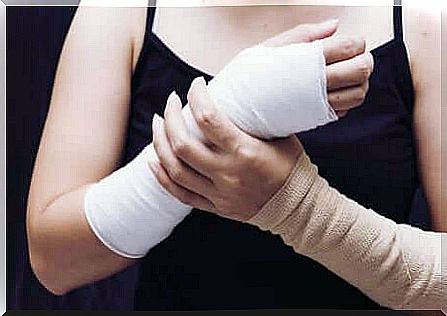Plaster Of Paris And Splint: Use And Care
What is the difference between a plaster of paris and a splint? And in which case do you get what? What kind of care do you have to give them in each case? In this article you will find the answer to all of these questions.

A cast and splint are used to protect injured parts of the body. This can speed up the healing process. Because the movements are restricted. And at the same time, this helps relieve pain. Usually the plaster of paris and splint are plastic, fabric, plaster of paris, or fiberglass.
The purpose of the plaster of paris and splint is basically the same. But there is one difference between them: and this has to do with the possible inflammation of the injury.
Because if there is an inflammation, a splint is the better choice. This enables an appropriate and comfortable adjustment. In this way you can avoid circulatory disorders and greater pain.
As soon as the inflammation subsides, the splint is usually replaced with a cast. Because this is harder and more compact. This ensures better protection of the injured part of the body. It doesn’t matter whether it’s a sprain or a broken bone.
Care of plaster of paris and splint
The materials and the circumstances under which plaster of paris and splint are used are different. But when it comes to care, the same applies to both. In the following we will show you what to look out for.
1. Keep the cast and splint dry

Although nowadays you can already find waterproof models of plaster of paris and splint: the vast majority are not yet. So you have to be extra careful not to let them get wet. So what to do when you want to shower or bathe? Then you should cover it with a plastic bag or a doctor-recommended cover.
Because if they get wet and the moisture gets into the inner layer that comes into contact with the skin, it does not dry easily. And that can lead to rashes, itchy skin and, in extreme cases, even an infection.
2. Try not to scratch yourself
Itching and burning, as sometimes occurs with plaster of paris and splint, can be downright unbearable. Have you ever experienced that too?
Then you have probably tried using a pencil or other pointed object to scratch yourself under the cast or splint. But that’s a mistake. Because residues can remain from your aids. And these can cause infection.
But there is a way to relieve this feeling of itching: for example, you can use a hair dryer and use it to blow cold air into the gap between the cast and the splint and the skin. While it won’t completely go away from the itching either, this trick will at least give you some relief.
3. Look for possible cracks
Sometimes it can happen that cracks form in the material of the plaster of paris and splint. And that can lead to problems. Therefore, you should also pay attention to whether there is a place that has been deformed by a small impact or something similar. Or whether there is one area that feels softer than the rest.
If there is such a change in the plaster of paris and splint, it can lead to wounds. And also worsen inflammation and cause greater pain. It is therefore advisable to pay close attention to any reddening of the skin every day. Because this way you can avoid complicating the injury.
4. You should change the material of the plaster of paris and splint as little as possible

You probably know that too: you make drawings on your plaster of paris or ask friends to write a dedication on it. Basically this is not a problem. But it can become one as soon as some of the cotton that is in contact with the skin is removed or damaged.
Because this can lead to serious inflammation. So try not to change the material of the plaster of paris and splint. Nevertheless, you can of course write on it without any problems. It is best to use a permanent marker for this. Because that way you will pollute the plaster of paris and splint the least.
What else to look out for
In addition to the care tips mentioned above, you should also pay special attention to the following: Be aware of your different sensations. Because these can actually be important messages. If you ignore them, you can seriously endanger your health. Some of them can be these:
- You feel a tingling sensation in your fingers or toes because these limbs fall asleep.
- You may also lose sensation in the affected limbs.
- Another alarm signal: the skin is starting to turn blue, white or purple.
- You should also be aware of any reddening of the skin around the cast and splint.
- The injured part of the body shows inflammation in the area of the cast and splint.
If you notice any of these signs, it is imperative that you see a doctor right away. In no case should you wait to see whether the inflammation or redness goes away, or whether the limb tenderness returns. Because that can lead to serious problems.
If you also have a fever or an unusual smell, and if the pain does not go away with the pain relievers prescribed by your doctor, you should go to the emergency room.
But plaster of paris and splint are usually not a problem. But of course it is better to know about proper care and any alarm signals. Because in this way you can seek help as quickly as possible and avoid complications in the event of an emergency.









